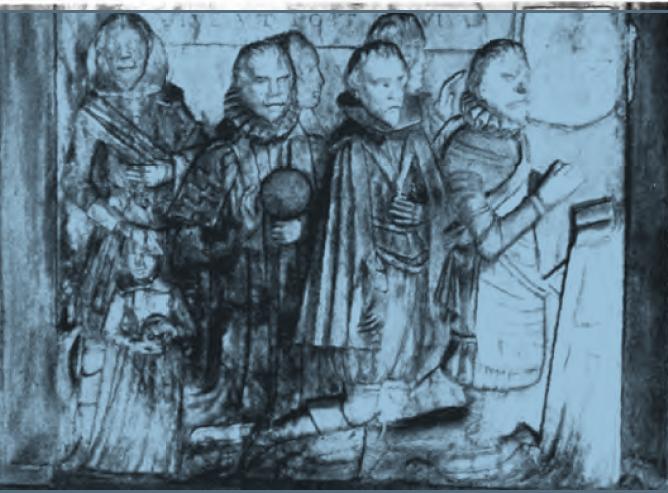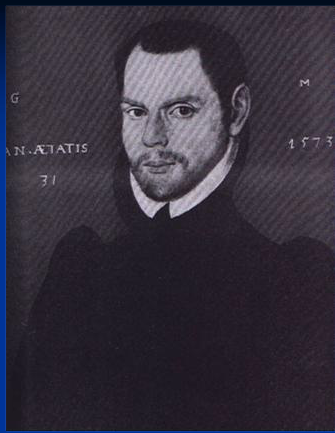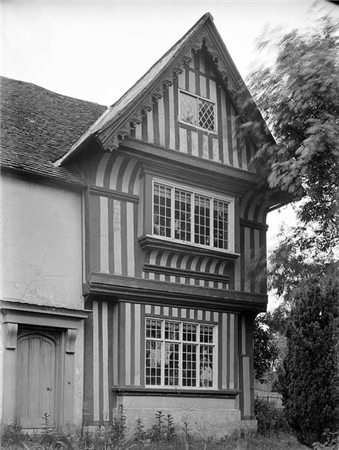In recent posts I’ve written about Thomas Lucke, the former Augustinian canon who was precentor of Michelham Priory, Sussex, until its suppression by Thomas Cromwell in 1537, and who was serving as a curate in the neighbouring parish of Litlington at the time of his death in 1552. Thomas was the brother of my 13 x great grandfather Richard Lucke of Mayfield, and Richard was the father of Alice Lucke who married Magnus Fowle: they were my 12 x great grandparents.
In my last post I noted that Thomas Lucke’s will of 1551, with its explicitly Catholic preamble, suggests that Thomas retained his attachment to England’s traditional faith, despite the fact that when he made his will he was serving as a priest in the reformed Church of England, two years after the Catholic mass had been banned by Edward VI. In addition to this evidence of Thomas’ religious sympathies, his will is also a useful source of information about his relatives and contemporaries, including as it does a substantial number of bequests. I’ve been following up some of these names, in an attempt to understand the milieu in which Thomas Lucke, and my other sixteenth-century ancestors, lived.
In his will, Thomas Lucke makes a number of bequests to his niece Alice, my 12 x great grandmother. One of them reads as follows:
I wyll of that monye that ys in Gregorye Martynes hands of Mayghfelde xlv to the povertie there to be dystrybuted by my executor. And the Resydue of the monye in his hands, I wyll halfe to Alice Lucke: the other halffe I wyll equally betwene Thomasyn Lucke and Elizabeth Lucke, by the hands of my executor to theme to be delyvred.
Gregory Martyn (or Marten, or Martin) is the only name that occurs both in Thomas’ will of 1551, and in the will of John Lucke of Mayfield, composed two years earlier in 1549 (see the previous post for my comments on the Catholic references in John’s will). I’m fairly certain that John was a relative of Thomas’, and may indeed have been another of his brothers. The witnesses to John Lucke’s will are listed as follows:
Richard lukk John Mone Gregory mtty: John Wenborn wm penkherst with others
I’m almost certain that ‘mtty:’ is an abbreviation for ‘Martyn’ and that this is the same person who would be mentioned in Thomas Lucke’s will. There is at least one reference to Gregory Martin of Mayfield in the manorial court rolls from Edward’s reign: for example, on 4th October 1551 he was one of the twelve men ‘appointed for the lord king’ to the court; my ancestor Richard Lucke was another. However, my search for additional information about Martyn in the contemporary records has proven somewhat frustrating. His name does not appear in the 1524-5 lay subsidy rolls for Mayfield or indeed for anywhere else in Sussex, though the names of Christopher, Laurence and Thomas Marten can be found in the Mayfield listing. Nor can I find a will for a Gregory Martin in the Sussex archives.
However, there is one other reference to a Gregory Martin in the records, and it’s an intriguing one. In 1529 Robert Sawyer of Mayfield made his will. The opening paragraph is in Latin and it culminates in a list of witnesses, which includes the name ‘Gregorio Marten’. The word that follows this name is difficult to read, but it could be ‘clico’, which might be an abbreviation for ‘clerico’. Indeed, the transcript by the Sussex Record Society translates the word as ‘clerk’: in other words, priest.
Is this the same person who would appear in the wills of John and Thomas Lucke some twenty years later, and was he really a priest? Unfortunately, I’ve found no trace of a Gregory Martin in the clergy records, but they only begin in 1540. Could he have been a member of a religious order, rather than a secular priest? Then again, if the person mentioned in those later wills was a priest, why was he not described as such, given that Thomas Lucke doesn’t hesitate to append the word ‘clerke’ to the name of Richard Cressweller, one of the witnesses to his will? Had Gregory Martin ceased to serve as a priest by 1551, or is this a different person altogether?
Interestingly, my search online for clues as to the identity of Gregory Martin led me to a very different person with the same name: the Catholic priest, scholar and author who was chiefly responsible for the Douai-Rheims translation of the Bible that first appeared in 1582. Although this Gregory Martin’s origins are largely obscure, it’s said that he was born at Maxfield, in the parish of Guestling near Winchelsea – also in Sussex. Indeed, an introductory chapter to Martin’s book Roma Sancta, by George Bruner Parks, includes the following speculation:
There was an older ‘Gregory Martin clerk’ at Maughfield or Mayfield in northeast Sussex in 1529 and again in 1551, and the unusual Christian name makes it almost certain that he (if he was one man) was related to our author. If so, this priest, though he is not listed at either university, must have influenced the younger man’s schooling and vocation.
The references here are to the wills of Robert Sawyer (1529) and my ancestor Thomas Lucke (1551). One thing is certain: the Gregory Martin mentioned in Thomas Lucke’s will can’t be the priest and translator of the Bible, since the latter was probably born some time in the 1540s and would still have been a child when Thomas died. We know that this Gregory Martin went up to the newly-founded St John’s College, Oxford in 1557, as one of its first scholars, where he befriended and may have influenced the conversion of the future Catholic priest and martyr Edmund Campion. For a time Martin was a tutor in the household of the Duke of Norfolk, before the increasingly hostile atmosphere for Catholics under Elizabeth I prompted him to travel to the continent and join the English College at Douai. After a sojourn in Rome, he returned to the College at its new home in Rheims, where he worked on his translation of the New Testament, before dying of consumption soon after its publication.
As already noted, Father Gregory Martin was said to come from Guestling, near Winchelsea. At the time of the lay subsidy rolls of 1524-5, there was a John Marten living in the parish and two William Martens. As for Maxfield, reputed to be the Marten family home, there is still a house in Guestling known as Great Maxfield. Apparently the property belonged to Battle Abbey until its dissolution in 1538. However, I’ve found no trace in the records of any association between Maxfield and the Martin family. At one stage, this made me doubt the sources that claimed Maxfield as Gregory’s home: I even wondered if somebody had once misread ‘Mayfield’ as ‘Maxfield’ and the misunderstanding had become accepted as fact. The earliest source I’ve found is an 1843 edition of A Defence of the Sincere and True Translations of the Holy Scriptures Into the English Tongue, Against the Cavils of Gregory Martin by the Puritan divine William Fulke, a contemporary of Martin’s. I wonder if the assumption that Martin was born at Maxfield is based on any earlier sources?
On the other hand, if we could prove a connection, it might be further proof of the Catholic sympathies of my Lucke ancestors, especially if Gregory Martin of Mayfield was actually a (former?) priest. However, even if he turns out to have been born elsewhere in Sussex, and even if he was from Mayfield, we have no evidence to connect him with the Gregory Martin of Mayfield mentioned in the wills of John and Thomas Lucke. The fact that they shared a name, and an unusual one at that, suggests some kind of connection – but what?
I’d be interested to hear from anyone with more information about Father Gregory Martin, particularly if you know of any research into his family background.





Reblogged this on History's Untold Treasures and commented:
H/T Recusants and Renegades
LikeLike
Thanks for reposting, Meghan. All best wishes, Martin.
LikeLike
Your welcome! Thanks for the great post!
LikeLike
Dear sir, i have just come across your blogs, perhaps you can help me ? I am searching one Alexander Lucke of the Chart Sutton area of Kent.(poss father a william) He married Jane Guildford circa 1562, and their daughter Alice, married John Dortenoll. I am trying to confirm if Jane is the daughter of Sir John Guildford. I am also having difficulty finding more details of the Lucke family.
any help you can provide would be much appreciated..
David Hanchard
LikeLike
Dear David, I apologise that I’m only now responding to your query. I’ve neglected this site over the past few years. I’m sorry, I don’t have any further information about the Lucke family: everything I know about them is on this site, and on my ‘Yeomen and Kinsmen’ blog, which you can find here: https://yeomenandkinsmen.wordpress.com/. Best wishes, Martin.
LikeLike